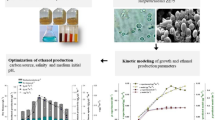Abstract
Pseudomonas putida NCIMB 11767 oxidized phenol, monochlorophenols, several dichlorophenols and a range of alkylbenzenes (C1–C6) via an inducible toluene dioxygenase enzyme system. Biphenyl and naphthalene were also oxidized by this enzyme. Growth on toluene and phenol induced the meta-ring - fission enzyme, catechol 2,3-oxygenase, whereas growth on benzoate, which did not require expression of toluene dioxygenase, induced the ortho-ring-cleavage enzyme, catechol 1,2-oxygenase. Monochlorobenzoate isomers and 2,3,5-trichlorophenol were gratuitous inducers of toluene dioxygenase, whereas 3,4-dichlorophenol was a fortuitous oxidation substrate of the enzyme. The organism also grew on 2,4- and 2,5-dichloro isomers of both phenol and benzoate, on 2,3,4-trichlorophenol and on 1-phenylheptane. During growth on toluene in nitrogen-limited chemostat culture, expression of both toluene dioxygenase and catechol 2,3-oxygenase was positively correlated with increase in specific growth rate (0.11–0.74 h−1), whereas the biomass yield coefficient decreased. At optimal dilution rates, the predicted performance of a l-m3 bioreactor supplied with 1 g nitrogen l−1 for removal of toluene was 57 g day−1 and for removal of trichloroethylene was 3.4 g day−1. The work highlights the oxidative versatility of this bacterium with respect to substituted hydrocarbons and shows how growth rate influences the production of competent cells for potential use as bioremediation catalysts.
Similar content being viewed by others
References
Boyd DR, McMordie AS, Porter HP, Dalton H, Jenkins RO, Howarth OW (1987) Metabolism of bicyclic aza-arenes by Pseudomonas putida to yield vicinal cis-dihydrodiols and phenols. J Chem Soc Chem Commun 19: 1722–1724
Boyd DR, McMordie RAS, Sharma NA, Dalton H, Williams P, Jenkins RO (1989) Stereospecific benzylic hydroxylation of bicyclic alkenes by Pseudomonas putida: isolation of (+)-R1-hydroxy-1,2-dihydronaphthalene, an arene hydrate of naphthalene from metabolism of 1,2-dihydronaphthalene. J Chem Soc Chem Commun 6: 339–340
Brand JM, Cruden DL, Zylstra GJ, Gibson DT (1992) Stereospecific hydroxylation of indan by Escherichia coli containing the cloned toluene dioxygenase genes of Pseudomonas putida F1. Appl Environ Microbiol 58: 3407–3409
Brown CM, Stanley SO (1972) Environmentally-mediated changes in the cellular content of the ‘pool’ constituents and their associated changes in cell physiology. J Appl Chem Biotechnol 22: 363–389
Commandeur CCM, Parsons JR (1990) Degradation of halogenated aromatic compounds. Biodegradation 1: 207–220
Dagley S (1984) Microbial degradation of aromatic compounds. Dev Ind Microbiol 25: 53–65
Ensley BD, Gibson DT, Laborde AL (1982) Oxidation of napthalene by a multicomponent enzyme system from Pseudomonas sp. strain NCIB 9816. J Bacteriol 149: 948–954
Finette BR, Subramanian V, Gibson DT (1984) Isolation and characterisation of Pseudomonas putida PpF1 mutants defective in the toluene dioxygenase enzyme system. J Bacteriol 160: 1003–1009
Folsom BR, Chapman PJ (1991) Performance and characterization of a model bioreactor for the degradation of trichloroethylene by Pseudomonas cepacia G4. Appl Environ Microbiol 57: 1602–1608
Folsom BR, Chapman PJ, Pritchard PH (1990) Phenol and trichloroethylene metabolism by Pseudomonas cepacia G4: kinetics and interaction between substrates. Appl Environ Microbiol 56: 1279–1285
Gibson DT, Hensley M, Yoshioka H, Mabry TL (1970) Formation of (+)-cis-2,3 dihydroxy-1-methylcyclohexa-4,6-diene from toluene by Pseudomonas putida. Biochemistry 9: 1626–1630
Gibson DT, Subramanian V (1984) Microbial degradation of aromatic hydrocarbons. In: Gibson DT (ed) Microbial degradation of organic hydrocarbons. Dekker, New York, pp 181–252
Gibson DT, Yeh WK, Liu TN, Subramanian, V (1982) Toluene dioxygenase a multicomponent enzyme system from Pseudomonas putida. In: Nozaki S, Yamamoto Y, Coon MJ, Ernster L, Estabrook RW (eds) Oxygenases and oxygen metabolism. Academic Press, New York, pp 51–62
Heald S, Jenkins RO (1994) Trichloroethylene removal and oxidation toxicity mediated by toluene dioxygenase of Pseudomonas putida. Appl Environ Microbiol 60: 4634–4637
Jenkins RO, Dalton H (1985) The use of indole as spectrophotometric assay substrate for toluene dioxygenase. FEMS Microbiol Lett 30: 227–231
Jenkins RO, Stephens GM, Dalton H (1987) Production of toluene cis-glycol in glucose fed-batch culture using Pseudomonas putida. Biotechnol Bioeng 29: 873–883
Ka-Leung N, Neidle, EL, Ornston, CN (1990) Catechol and chlorocatechol 1,2-dioxygenase. Methods Enzymol 8: 122–126
Kataeva IA, Golovleva, LA (1990) Catechol 2,3-oxygenase from Pseudomonas aeruginosa 2x. Methods Enzymol 8: 115–121
Klecka GM, Gibson DT (1981) Inhibition of catechol 2,3-dioxygenase from Pseudomonas putida by 3-chlorocatechol. Appl Environ Microbiol 41: 1159–1165
Phelps TJ, Niedzielski JJ, Schram RM, Herbes SE, White DC (1990) Biodegradation of trichloroethylene in continuous-recycle expanded-bed bioreactors. Appl Environ Microbiol 56: 1702–1709
Robertson JB, Spain JC, Haddock JD, Gibson DT (1992) Oxidation of nitrotoluenes by toluene dioxygenase: evidence for a mono-oxygenase reaction. Appl Environ Microbiol 58: 2643–2648
Robinson J, Cooper JM (1970) Method of determining oxygen concentrations in biological media, suitable for calibration of the oxygen electrode. Anal Biochem 33: 390–399
Smith MR, Ratledge C (1989) Catabolism of alkyl benzenes by Pseudomonas sp NCIB 10643. Appl Microbiol Biotechnol 32: 68–75
Spain JC, Gibson DT (1988) Oxidation of substituted phenols by Pseudomonas putida F1 and Pseudomonas sp. strain JS6. Appl Environ Microbiol 54: 1399–1404
Spain JC, Zylstra GJ, Blake CK, Gibson DT (1989) Monohydroxylation of phenol and 2,5-dichlorophenol by toluene dioxygenase in Pseudomonas putida F1. Appl Environ Microbiol 55: 2648–2652
Wackett LP, Gibson DT (1988) Degradation of trichloroethylene by toluene dioxygenase in whole cell studies with Pseudomonas putida F1. Appl Environ Microbiol 54: 1704–1708
Yeh WK, Gibson DT, Liu TN (1977) Toluene dioxygenase: a multi component enzyme system. Biochem Biophys Res Commun 78: 401–410
Author information
Authors and Affiliations
Rights and permissions
About this article
Cite this article
Heald, S.C., Jenkins, R.O. Expression and substrate specificity of the toluene dioxygenase of Pseudomonas putida NCIMB 11767. Appl Microbiol Biotechnol 45, 56–62 (1996). https://doi.org/10.1007/s002530050649
Received:
Revised:
Accepted:
Issue Date:
DOI: https://doi.org/10.1007/s002530050649




